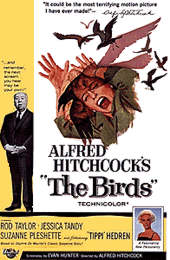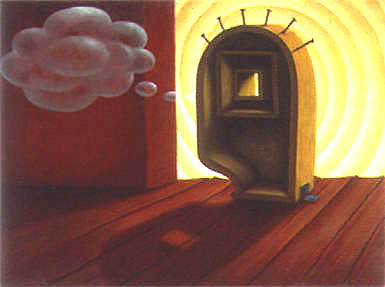Preface
by Mitch Gillette
 The
first movie I ever saw in the absence of my parents was Alfred Hitchcock's The
Birds. I'm not sure why it was that film in particular. If my Mom and Dad
had known what The Birds was about, they never would have let me go.
I went with my best friend Michelle and her older brother Kevin, who was high
school age, and I guess my folks thought I was in good hands.
The
first movie I ever saw in the absence of my parents was Alfred Hitchcock's The
Birds. I'm not sure why it was that film in particular. If my Mom and Dad
had known what The Birds was about, they never would have let me go.
I went with my best friend Michelle and her older brother Kevin, who was high
school age, and I guess my folks thought I was in good hands.
Today The Birds is
probably my favorite movie. Not only because it's a blast, but because
of what it's made up of. When I watch it I see a wonderful controlled subversion
of what we consider "natural in nature." And I see a handsome
self-consciousness, the extreme opposite of cinema verite, a vision that is
planned and bent and prodded into a final work.
In a way these two elements
constitute the main ingredients to my work. When I was even younger (pre-Birds),
I was seriously addicted to Superman comic books. I was forever copying
my favorite covers and pages over and over again. My Uncle Linwood, himself
a cartoonist (or so he claimed, though I don't remember ever seeing a single
cartoon), loaned me a two volume cartooning course, thinking I might follow
in his footsteps. Surprisingly, the books were almost entirely about anatomy. I
soon discovered that it wasn't the stories that drew me to Superman, but rather
Superman and Lois Lane's bumps and curves.
 The
body is the center of my stuff. Even when I make a picture with no body
in it, there is still some sort of reference to the human form. I can't
seem to get enough of the nude figure--male, female, I love it all. Other
figure painters dread the hard parts, like the hands and feet. Not me. Let
The
body is the center of my stuff. Even when I make a picture with no body
in it, there is still some sort of reference to the human form. I can't
seem to get enough of the nude figure--male, female, I love it all. Other
figure painters dread the hard parts, like the hands and feet. Not me. Let
At some point in the progression
of my work, the figure became a symbol. Fresh from dropping out of art
school, I drew and painted from models until the boredom overtook me a few months
later. I started to draw the human body from my head using memories of
Uncle Linwood's books. The new figures became stretched and distorted as
I unconsciously relied more on my instincts and the nature of my own gesture.
I began to forget to remember what real anatomy looks like. The less I
concentrated on reality, the less my figures seemed to be about the figure itself
and more about a kind of commentary on the figure. And I guess I would
just unconsciously dump stuff from my head into whatever I was working on. None
of this was really on purpose; meaning is always furthest from my mind when
I'm composing a picture.
So in a sense, like Hitchcock,
I found myself subverting nature. But unlike Mr. Hitchcock, whose psycho-sexual
concerns were veiled and revealed themselves only through suggestion, sexuality
became a major theme in my work. It became my calling card.
 That
self-conscious quality I see when I watch The Birds also plays a big
part in what I do. Some would call it post-modern--the reusing or funneling
of older styles and conceits for new purposes. The basis of my style has
it's origins in classical painting, but my conceptual concerns are far from
anachronistic. I am in fact subverting tradition for effect (yes, more subversion).
That
self-conscious quality I see when I watch The Birds also plays a big
part in what I do. Some would call it post-modern--the reusing or funneling
of older styles and conceits for new purposes. The basis of my style has
it's origins in classical painting, but my conceptual concerns are far from
anachronistic. I am in fact subverting tradition for effect (yes, more subversion).
This mix of subverted traditions
and subverted bodies makes for some fairly vulgar imagery. Lushly, wonderfully
vulgar, I hope. Some people are put off by this, and I don't blame them.
My work has never been for the faint of heart or the hopelessly tasteful. But
this is what I do.
 The
first movie I ever saw in the absence of my parents was Alfred Hitchcock's The
Birds. I'm not sure why it was that film in particular. If my Mom and Dad
had known what The Birds was about, they never would have let me go.
I went with my best friend Michelle and her older brother Kevin, who was high
school age, and I guess my folks thought I was in good hands.
The
first movie I ever saw in the absence of my parents was Alfred Hitchcock's The
Birds. I'm not sure why it was that film in particular. If my Mom and Dad
had known what The Birds was about, they never would have let me go.
I went with my best friend Michelle and her older brother Kevin, who was high
school age, and I guess my folks thought I was in good hands. The
body is the center of my stuff. Even when I make a picture with no body
in it, there is still some sort of reference to the human form. I can't
seem to get enough of the nude figure--male, female, I love it all. Other
figure painters dread the hard parts, like the hands and feet. Not me. Let
The
body is the center of my stuff. Even when I make a picture with no body
in it, there is still some sort of reference to the human form. I can't
seem to get enough of the nude figure--male, female, I love it all. Other
figure painters dread the hard parts, like the hands and feet. Not me. Let
